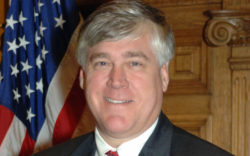Clarke and other North Georgia counties survived a serious drought in 2008 by restricting outdoor water use, like watering lawns, to certain days and hours. Even after the rains returned, “people have changed how they use water outside,” Water Resource Planner Marilyn Hall told Athens-Clarke County commissioners last week. Water demand dropped and stayed lower after the drought.
Conservation worked, but county planners are looking toward building infrastructure to ease the pain of the next drought. The probability of such a drought is small, Hall said, but if water restrictions ever had to be extended to commercial users, as many as 4,000 jobs could be lost, she said. Even without a drought, ACC’s water use is gradually increasing as the population grows, and could exceed its permitted withdrawals from Bear Creek Reservoir, which is owned jointly by four counties, by 2050.
Proposed solutions include more water stored in reservoirs, and also recycling wastewater for some non-drinkable uses. Treated wastewater, currently discharged into rivers, could instead have chlorine added and be recycled for, say, flushing toilets in buildings—like UGA’s new I-STEM research building—whose plumbing accommodates such uses.
But Athens’ first user of recycled wastewater will be UGA’s water chiller plant off Baxter Street, which cools most central campus buildings. Separate pipes will deliver wastewater from the treatment plant off College Station Road. The treated wastewater will replace the fresh water now used, at perhaps half the cost to UGA, and fresh drinkable water will not be wasted in uses where it is not really needed.
Pipes are already being laid for projected future uses of recycled water in industrial areas in northern Clarke County. Eventually, Hall said, wastewater could even be treated sufficiently to drink. As water supplies become more critical, “we’re going to start seeing that more and more all over the country,” she said.
The county-owned parking lot downtown that is overlooked by the Hot Corner mural will soon become a small park. At the Jan. 13 work session, commissioners got a first look at possible plans for the one-fifth-acre park at the corner of Washington and Lumpkin streets, behind the Water Business Office and across Lumpkin from First United Methodist Church. Instead of a parking lot, the mural will eventually overlook trees and a grassed area with benches and a small performance area.
Local design firm WLA Studio polled the public online and in person, and “the majority of people wanted this to be a green space,” WLA’s Keyes Williamson told commissioners. Of several plans, most commissioners liked an informal layout with curving “seat walls” around a grassed area, plus a few tables and chairs. They also liked the idea of small mounds that kids could play on. “We really need something for kids downtown,” Commissioner Russell Edwards said.
A three-panel sculpture wall by local artist Harold Rittenberry has been offered to the county as a gift and could be included in the park, which might be built as early as this summer. Commissioner Tim Denson said he hopes more downtown parks will eventually follow: perhaps a larger park on downtown’s north side, and a College Square park.
And in Dudley Park, across the river from downtown, a walkway will be completed to surround a circular hilltop “festival field” with adjacent restrooms and a large picnic pavilion—at a cost of $890,000, mostly funded by a 2011 round of sales taxes. The festival field, on the Oconee Street side of the park south of Firefly Trail, will include a setup spot for the county’s portable “Showmobile” stage.
Several commissioners asked whether a basketball court might be included. “It’s a sore spot for [nearby residents] that there are no basketball courts in that park anymore,” said Commissioner Melissa Link. Other desired amenities—like a playground, boat launch or permanent stage—could not be built within budget. Once a final plan is approved, improvements could be finished by fall.
Like what you just read? Support Flagpole by making a donation today. Every dollar you give helps fund our ongoing mission to provide Athens with quality, independent journalism.










